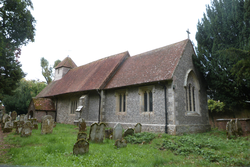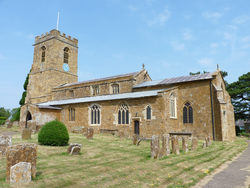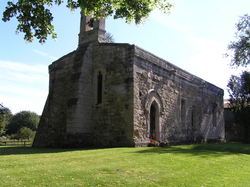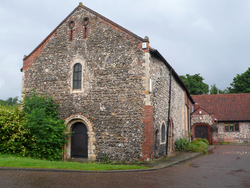
The Corpus of ROMANESQUE SCULPTURE in Britain & Ireland

St Mary Magdalen (now)
Parish church
A small medieval parish church of rubble with ashlar quoins and dressings. The church has a 13thc. chancel, and 15thc. nave, W tower and S porch. The S transept is 19thc., forming part of restorations in 1886 by John Belcher. The only 12thc. features are the simple N and S doorways and the plain font. The doorways were retained or reset in the 15thc. when the aisleless nave was rebuilt.
Parish church
West Tisted is a small building, even more so when it is realised that the chancel is 19thc, even though the whole exterior is identically clad in flint. It has a blocked Romanesque N door, and a piscina in the S wall at the end of the medieval nave, presumably by the rood altar, but there is no surviving chancel arch.
Parish church
Wardington is in the extreme north of Oxfordshire, 5 miles NE of Banbury. It is known that a chapel existed here by the C12th. The church now consists of chancel, nave, N and S aisles, a S chapel, W tower, and vestry. The existing nave and both aisles were built in the C13th and the W tower c. 1400. Although the chancel was remodelled in the C14th, it retains some fragmentary Romanesque features, including two window arches in the chancel, visible internally, and parts of the imposts of the N side of the chancel arch. The E arch of the N arcade, which may have been the entrance to a N transept, also has responds with imposts dating from the C12th.
Hospital chapel
Ripon is a cathedral city and market town in the Harrogate district of North Yorkshire. The chapel of St Mary is a single-cell building with a rectangular plan (see Poole, 1845). The only obvious C12th remains are the outer arches of the S doorway. The stone used for this is a light orange sandstone. According to McCall, the building was refaced in the 15th century and restored from a dilapidated state around 1917; according to Leach and Pevsner (2009), p. 668, it restored again in 1989. Glynne in 1864 records it as 'curious and but little altered', by which he must mean in modern times (see Butler, 2007, 342-3, with two illustrations of its state in 1842).
Features of interest include a blocked doorway and medieval altar slab.
Hospital, former
This remarkable buiilding, located at the corner of Sprowston Road and Gilman Road in Norwich, is now part of a modern care complex. The remains of the infirmary hall of a hospital founded by the first bishop, Herbert de Losinga (1096-1119) to the north of the city beyond the Magdalene Gate, its east end was demolished after the Dissolution. Its two carved doorways probably survive from the original structure. Badly weathered, apparently reinserted in their present location, restored and partly reassembled, they bear the only Romanesque sculpture at the site. Their significance resides in their dated context and their ornament, for they are decorated with distinctive geometric motifs also occurring on voussoir fragments found to have been re-used when the original 12thc cloister of Bishop Herbert's cathedral was rebuilt in the 14thc.




